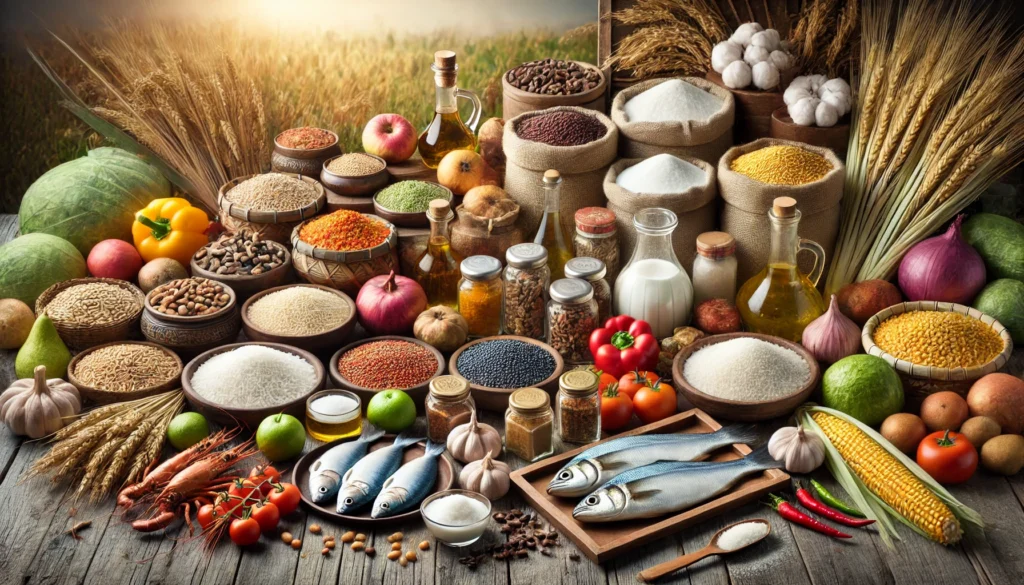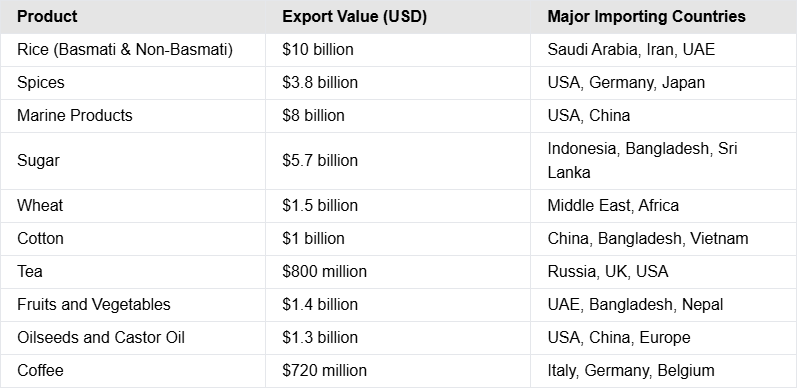
India, known as the “Land of Agriculture,” has established itself as a significant player in the global agricultural market. With its diverse climate, rich soil, and abundant resources, the country produces a wide range of agricultural products that are exported worldwide. In this article, we will explore the top 10 agricultural products exported from India globally, highlighting their economic impact and global significance.
Top 10 Agricultural products
1. Rice
Basmati Rice
India is synonymous with Basmati rice, a fragrant and long-grain variety that is highly sought after worldwide. Indian Basmati rice is exported to countries like Saudi Arabia, Iran, and the UAE, with its annual export value exceeding $4 billion.
Non-Basmati Rice
Apart from Basmati, India also exports non-Basmati rice, which contributes significantly to its agricultural export portfolio. Non-Basmati rice is exported to African and Southeast Asian countries, generating $6 billion annually
2. Spices
India is the “Spice Capital of the World,” contributing over 75% of the global spice trade. Popular spices like turmeric, cumin, cardamom, and black pepper are exported to the USA, Germany, and Japan. The annual export value of Indian spices stands at approximately $3.8 billion.
3. Marine Products
Marine exports, including shrimp, fish, and crab, form the backbone of India’s agricultural exports. Frozen shrimp is a top product, with the USA and China being major importers. The export value of marine products surpasses $8 billion annually, making it the highest contributor among agricultural exports.
4. Sugar
India, being one of the largest producers of sugar, exports substantial quantities to Indonesia, Bangladesh, and Sri Lanka. With an annual export value of around $5.7 billion, sugar remains a key agricultural product in India’s export basket.
5. Wheat
India’s wheat exports have grown steadily over the years, particularly to countries in the Middle East and Africa. Wheat contributes approximately $1.5 billion to India’s annual agricultural export earnings.
6. Cotton
Indian cotton, known for its high quality, is exported to China, Bangladesh, and Vietnam for textile manufacturing. The annual export value of cotton from India is around $1 billion, making it a crucial agricultural commodity.
7. Tea
India’s Darjeeling and Assam teas are globally renowned for their flavor and aroma. Countries like Russia, the UK, and the USA are major consumers of Indian tea, which contributes $800 million annually to the export economy.
8. Fruits and Vegetables
India exports a variety of fresh fruits and vegetables, including mangoes, bananas, onions, and tomatoes. Key markets include the UAE, Bangladesh, and Nepal. This sector generates an annual export revenue of approximately $1.4 billion.
9. Oilseeds and Castor Oil
India is the world’s largest producer and exporter of castor oil, which is used in industrial and pharmaceutical applications. The export value of castor oil alone is $1.3 billion, with significant markets in the USA, China, and Europe.
10. Coffee
Indian coffee, particularly from regions like Coorg and Chikmagalur, is celebrated for its rich aroma and flavor. India exports coffee to countries like Italy, Germany, and Belgium, with an annual export value of approximately $720 million. The unique monsooned coffee, which undergoes a special aging process, is especially popular in international markets.
Indian Agriculture Export Data Table

The data in this article is taken from reliable sources, including APEDA (Agricultural and Processed Food Products Export Development Authority), the Ministry of Commerce and Industry, DGFT (Directorate General of Foreign Trade), and MPEDA (Marine Products Export Development Authority). Additional insights are derived from commodity-specific boards like the Spices Board, Coffee Board, and Tea Board of India, as well as international organizations such as FAO, the World Bank, and WTO.
Why India Excels in Agricultural Exports
Several factors contribute to India’s dominance in agricultural exports:
- Diverse Climate: India’s varied climate allows for the cultivation of a wide range of crops.
- Government Initiatives: Policies like the Agricultural Export Policy 2018 aim to double farmers’ income and promote exports.
- Infrastructure Development: Improved cold storage and transportation facilities ensure product quality.
- Global Demand: Increasing demand for organic and high-quality products boosts India’s export potential.
Challenges in Agricultural Exports
Despite its success, India faces challenges in the agricultural export sector:
- Logistical Issues: High transportation costs and inadequate storage facilities can hinder exports.
- Regulatory Barriers: Stringent quality standards in importing countries pose challenges for exporters.
- Price Volatility: Fluctuating global prices affect profit margins for exporters.
Conclusion
India’s agricultural exports play a vital role in the country’s economy, showcasing its rich agricultural heritage and global competitiveness. By addressing existing challenges and leveraging its strengths, India can further solidify its position as a leading agricultural exporter. From rice to marine products, the top 10 agricultural products exported from India globally are a testament to the nation’s agricultural prowess and its significant contribution to the global market.
